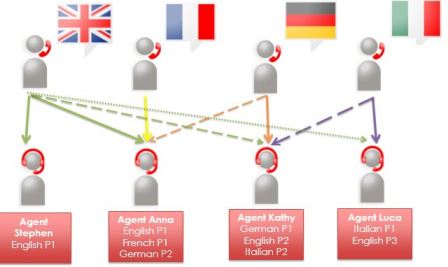
Call routing is an essential part of the contact centre. When used well, an efficient routing system helps to deliver a fantastic experience to customers with a fast resolution to their query; but get call routing wrong and it can be a source of immeasurable frustration, ultimately leading to poor service and customer churn.
So, why are so many businesses failing when it comes to this essential component? It’s often due to legacy call centre systems that are no longer up to the job. Many businesses are simply unaware of the capabilities of modern technology and the ease with which they can be deployed and rolled out. Below are 7 innovative ways to improve call routing within your business.
#1. Skill Levels
In today’s modern contact centre, simply defining agents’ skills based on ACD queues or types of calls in order to match customers with the best agent is no longer enough. The modern contact centre needs to take into account skill levels to more effectively match customers with an appropriate agent.

#2. Monitor the queue
While having the optimum configuration for your skills-based routing tool is important, your business also needs to monitor the queues to identify bottle necks or skill shortages. Following identification of a skill shortage or bottle neck, your business might opt for training agents in their current skills to increase their efficiency, as well as teaching agents new skills. Ideally any contact centre strives for ‘super agents’ – highly skilled product experts who have the ability to deal with complex problems, however, it is advisable not to overload newer agents with too many different skills; you must ensure they can walk before they run.
#3. Use advanced self-service options
Advanced self-service is the most effective way to include skill levels discussed above. A customer inputs details such as an account or reference number and the information can then be used to perform an intelligent data look up in the CRM system in order to quickly identity customers. Calls can then be routed much more effectively and high value customers could even be flagged up with the option of being put into a VIP queue or routed towards specialist agents.
#4. Cross-selling in the queue
Of course no one wants to queue but sometimes it’s going to be inevitable. Offer targeted and relevant marketing messages to customers while they wait (using intelligent data look ups mentioned above). This could include new products as well as products the customer has enquired about in the past but not completed the purchase. Data shows more than 50% of callers complete a purchasing during the second opportunity.
#5. Route additional calls to the agent they last spoke to
Repeating the same problem to multiple agents can be frustrating. Using data look-ups, calls can be routed to the last agent that the customer spoke to (provided they are available) or check to see which agent is dealing with their enquiry or open ticket and route the call straight through to them from the off. This allows customers to receive a better standard of customer service and build rapport with the agent, removing the frustrations of being passed around and having to repeat the problem or query.
#6. Create a call option within your app
This is common with many mobile banking apps which require a passcode to access. This option allows customers to make a call within the app and uses their information in the same way that advanced self-service would. This allows businesses to streamline their inbound calls with no need for customers to complete a security check while creating a fast and efficient process for the customer.
#7. Call backs
Offer customers the option of receiving a call back when the queue reaches a certain capacity. Call backs are a great way of allowing customers to get on with their daily tasks without having to stay on the phone.
A good system will not just offer a ‘virtual placeholder’ with a call-back from the next available agent but it will also allow customers to choose a different timeslot that is more convenient to them – perhaps later on in the day. What’s more they could even choose to input an alternative phone number on which to be called back; offering even greater flexibility and choice for the customer.
Overall, inbound call routing done correctly is an effective tool to improve the customer’s experience by getting the customer to the best agent as quickly as possible, prioritising high value customers and minimising additional wait times.
Furthermore, effective call routing can improve the bottom line through more streamlined calls, efficient time management and a subsequent uplift in sales.

For additional information visit the Magnetic North Website



